Can You Sense It? Part 2: The Video Art of Tamika Galanis
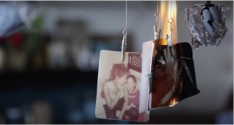
28, by Tamika Galanis
THE VIDEO ART OF TAMIKA GALANIS
Streaming May 2 - May 9, 2021
All tickets include admission to the conversation on May 8.
Ticketing: Sliding Scale, $0 for members, $5 for students, $8, $12, $20 for Part 2 https://watch.eventive.org/canyousenseit/play/60802ab25d51ea008c42294e
Sliding Scale, $0 for members, $5 for students, $8, $12, $20, $30 for Both parts
https://watch.eventive.org/canyousenseit/play/607e48f1b7197c009ca52b45
We hope that, if your means allow, you might go for $20, as you will be getting to see multiple films and a wonderful conversation!
What are you sensing, around the political and public health disasters and through a year of virtual connections? Can you sense around and through disaster? What does your body feel? Where does your mind take you? Have you had extrasensory experiences lately? Are you connecting to other worlds and your communities beyond screens?
“Can You Sense It?,” programmed by guest curator Jacqui Brown for Los Angeles Filmforum, deeply engages the work of two filmmakers - Bridget Reweti and Tamika Galanis - to pull you through your screens and drop you beyond this global pandemic to connect deeply to what it is that only you can sense.
The works presented exist between the possibilities of film, grounded in land and place and people overlooked, placing nonfiction film in service of embodiment. They sever the connection between image and dialogue, facilitating the transfer of your energy away from your screen to your senses and the vibrations of land, place, and connections.
Bridget Reweti suffuses the Aotearoan landscape with voices, mythologies, and communality to dispel romantic notions of the “natural world” and close the gap between our natural and lived environments. Tamika Galanis reverses Reweti’s circulation of life to landscape, placing the outdoors in service of archiving Bahamian interiority. Tamika places herself in an unenviable race - capturing what is The Bahamas, as her home, known as “The Ephemeral Islands,” is actually disappearing.
Can you sense it? That for some of us, our worlds have been ending for centuries? Can you sense it? That our work never ended? Can you sense it? Your relationship to the source?
If you leverage your senses, these films will snatch you through the screen and set you down in fully formed worlds.
Tamika Galanis is a documentarian and multimedia visual artist. A Bahamian native, Galanis's work examines the complexities of living in a place shrouded in tourism’s ideal during the age of climate concerns. Emphasizing the importance of Bahamian cultural identity for cultural preservation, Galanis documents aspects of Bahamian life not curated for tourist consumption to intervene in the historical archive. This work counters the widely held paradisiacal view of the Caribbean, the origins of which arose post-emancipation through a controlled, systematic visual framing and commodification of the tropics.
Galanis’s photography-based-practice includes traditional documentary work and new media abstractions of written, oral, and archival histories. Hacking the Narrative is a multimedia project composed of photographs, film, and sculptural objects that shed light on the conditions in which Bahamians live outside of the mythical promise of paradise.
Galanis is based in Durham, North Carolina where she earned a Masters of Fine Arts in Experimental and Documentary Arts from Duke University.
Website: https://www.tamikagalanis.com/
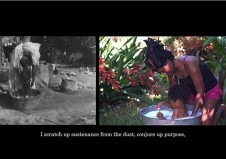
Returning the Gaze: I ga’ gee’ you what you lookin’ for!
Returning the Gaze: I ga’ gee’ you what you lookin’ for!
5:05
The United States Library of Congress is home to the oldest collection of motion pictures in the Western world; the First Films Paper Print Collection—also known as the Thomas Edison Collection— is named for the inventor of the motion camera. This installation includes four of the five films from the collection shot in the West Indies from 1901-1903. These moving images give life to still images we are accustomed to seeing in colonial collections; ethnographic in nature, both the films and their descriptions chronicle the imbalance of power enacted upon people of color whose likenesses were used post-Emancipation to further the colonial project throughout the West. The Anglophone Caribbean, in particular, has a contentious relationship with image-making: the dawn of photography birthed the tourism industry—the offspring of slavery—and the resultant paradisiacal narrative has remained relatively unchanged. Dr. Krista Thompson writes in her book, An Eye for the Tropics, about how iconic the image of the Black woman was in the systematic framing of the tropics for consumption: perceived as docile and most-accessible, her likeness—often highly sexualized—appears in disproportionate frequency to that of men throughout the region. The films from the First Films Collection demonstrate the liberties taken by the filmmakers; possessed of both the technological resources and power, the cameramen do not shy away from filming naked bodies of their subjects, and their subjects rarely object and hardly ever make eye contact, which is demonstrative of the white-male-gaze that accounts for so much of the canon. The First Films are a call and we have a response.
This project is a collaboration with community members as an homage to Bahamian, literary powerhouse, Patricia Glinton-Meicholas, whose prose lights a fire under our feet. While the images counter the outsider, male gaze, Patti’s words lend an additional layer of autonomy to the characters in the film who are the embodiment of resistance: as the struggle for women’s rights continues in this country, her words are a reminder to call our power back into ourselves—women unconquerable. Grounded in Bahamian vernacular, the responses are steeped in biggity familiarity.
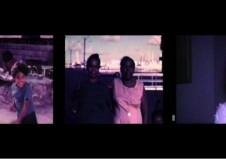
A Thousand Points of Light
A Thousand Points of Light
20:06
This video was installed as a part of my solo show, One Hurricane Season. The films are my family's home movies. "One Hurricane Season" is a personal attempt to synthesize the fallout of events on the macro level by examining the micro: while Hurricanes Irma and Maria tore through the Caribbean, forcing residents to grapple with what it felt like to wake up to irreparable damage, dealt out overnight, my family and I were being forced to do the same—a sudden onset and progression of dementia left us with a shadow of the woman we know and love." From Galanis's essay: https://main.oxfordamerican.org/item/1604-one-hurricane-season
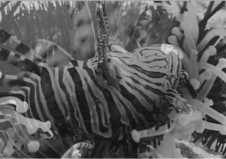
When the Lionfish Came
When the Lionfish Came
6:02
When the Lionfish Came is a six-minute experimental, short film that juxtaposes the natural world with the cultural environment. This film uses metaphor to address both the effects of capitalism and climate change in the Caribbean— particularly The Bahamas. The lionfish, predatory-outsider, non-native species in the Atlantic, has since the early 90s, wrought havoc on reef systems in the Atlantic Ocean. The lionfish’s high rate of predation in the Atlantic is attributed to its appearance — to the rest of the reef, it looks like it belongs. Multiplying at unthinkable rates, the lionfish gorges on the reef until it is depleted and moves on. This film is an illustration of disappearing Bahamian culture (through Junkanoo and reef imagery), the palpability of the absence of real climate change initiatives, and the continued pursuit of capitalistic endeavors (tourism) despite cultural decline. Using both shot and found footage and rendered in black and white to counter ideas of the tropical ideal, this film posits that perhaps the lionfish came to provide clear illustration of the region’s fate without intervention.
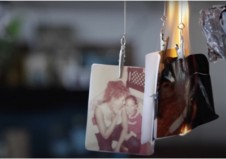
28
28
12:25
This film depicts the erosive effects of addiction on a familial relationship.
